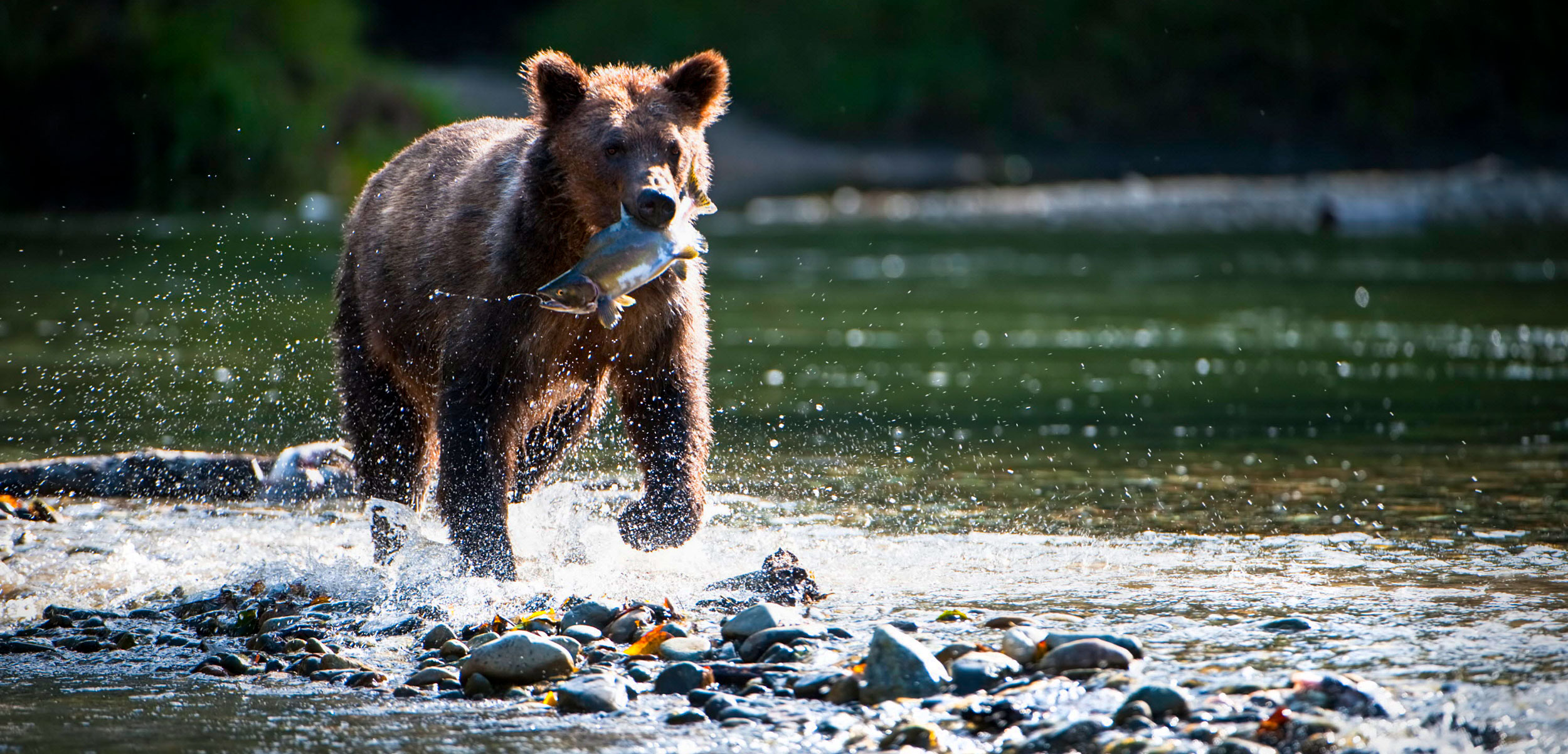New research reveals a curious connection between British Columbia’s Indigenous language families, and the genetic variability of bears.

Among British Columbia Indigenous language groups, the name for grizzly bears varies. But there are patterns to these names that suggest something interesting about the landscape in this region. Photo by Nick Garbutt/NPL/Minden Pictures
by Gloria Dickie
August 5, 2021 |
Along the central coast of British Columbia, grizzly bears go by many names. In the Sgüüx̣s language spoken by the Kitasoo Nation and the Sm’algyax language of the Gitga’at Nation, they are known as medi’ik. And in the Haíɫzaqvḷa, It7Nuxalkmc, ‘Wuik̓ala, and Xai’xais languages, bears are called nan. The reasons for such differences of language, new research suggests, may be similar to the reasons that grizzly groups differ genetically in the region.
A new study has found a remarkable geographical alignment between distinct grizzly bear genetic groups and three Indigenous language families—Tsimshian, Northern Wakashan, and Salishan Nuxalk—in coastal territories, suggesting that the rich landscape has similarly shaped both bears and humans.
“Bears are great teachers,” says Lauren Henson, the study’s lead author and a research fellow at the Raincoast Conservation Foundation. “People were using the same watersheds and the same salmon accesses for millennia. So, perhaps it would be more surprising if there wasn’t overlap between bear culture and human culture.”
Regions with a high degree of biological and cultural diversity, such as the Amazon Basin, Central Africa, and Indomalaysia/Melanesia, are considered biocultural hotspots. However, these are often determined by measuring species richness and linguistic diversity, explains Henson. Examining the finer scale of genetic groups within a species, she says, is an emergent aspect of biocultural research.
To assess how bears may be related across the landscape, Henson and her colleagues at the Raincoast Conservation Foundation, the Hakai Institute,* and other organizations, in collaboration with the Nuxalk, Heiltsuk, Kitasoo/Xai’xais, Gitga’at, and Wuikinuxv Nations, analyzed bear hair samples collected over a 23,500-square-kilometer area of the British Columbia central coast. This research revealed three distinct genetic grizzly groups—and that each group appeared to overlap with the language family of that given area.
Genetic groupings within species can often be explained by natural or human-made barriers on the landscape—high mountains, wide waterways, roads—that prevent movement and gene flow across populations. In interior grizzly populations, between central British Columbia and Wyoming, for instance, scientists have identified many genetic fractures and a few genetically isolated populations, owing to the millions of people living in the area, says Bruce McLellan, a wildlife ecologist recently retired from the British Columbia Ministry of Forests, Lands and Natural Resource Operations who was not involved in the research.
However, Henson and her team found that these factors couldn’t explain the pattern of genetic differences found in British Columbia’s coastal grizzlies. “Bears are all-terrain vehicles,” she says. “They can swim. They can climb mountains. They’re pretty adaptable.” Moreover, the central coast isn’t heavily developed—there aren’t a lot of roads and there aren’t a lot of people.
Henson believes it’s possible that variations in food and resources found along the coast have instead facilitated these diverse genetic groups. “Perhaps it’s less about what’s not allowing them to move and more about what’s allowing them to stay,” she says. And because bears and people have shared food and space for millennia, it follows that people might respond to the environment in a similar way, allowing for a rich diversity of languages to evolve in parallel.
“It really surprised me how these language groups and the areas of these distinct bear populations were one in the same,” says William Housty of the Heiltsuk Integrated Resource Management Department and coauthor of the study. “I’d never thought of it in that context—that the bears are separated geographically from each other the same way that we are from our neighbors.”
Clayton Lamb, a wildlife scientist at the University of British Columbia and University of Montana who is unaffiliated with the study, notes that the research makes a significant contribution to scientists’ understanding of genetic fragmentation, “in that distinct genetic groups can be identified in relatively intact landscapes.”
Such findings also have implications for the management of grizzly bears in British Columbia. Though genetic variations don’t always dictate a subspecies or change the physical appearance of an animal, they can identify groups of bears that are closely related and signal their adaptive capacity to respond to changes in the environment. Ideally, wildlife managers maintain population health by protecting a wide swath of genetic diversity to foster resilience. But British Columbia’s government divides grizzlies into population units that don’t follow the bears’ unique genetics, breaking up otherwise continuous groups and managing them differently. Though Lamb notes that many factors must be weighed when defining population units—diet similarities, contemporary movement between populations, and population size—“historical genetic signatures, such as those investigated here, inform how best to delineate these boundaries.”
“It’s really important to look at these bears at a ground-level scale,” adds Housty. “Management at a high level may not protect and maintain genetic diversity.”
* The Hakai Institute and Hakai Magazine are both part of the Tula Foundation. The magazine is editorially independent of the institute and foundation.
No comments:
Post a Comment